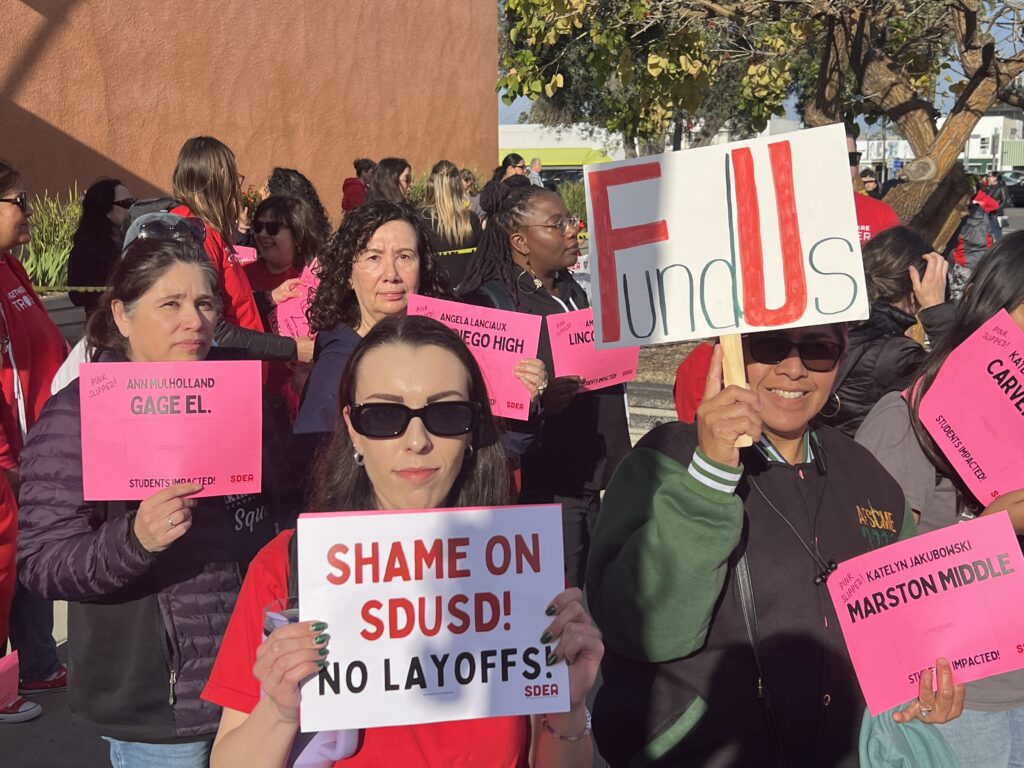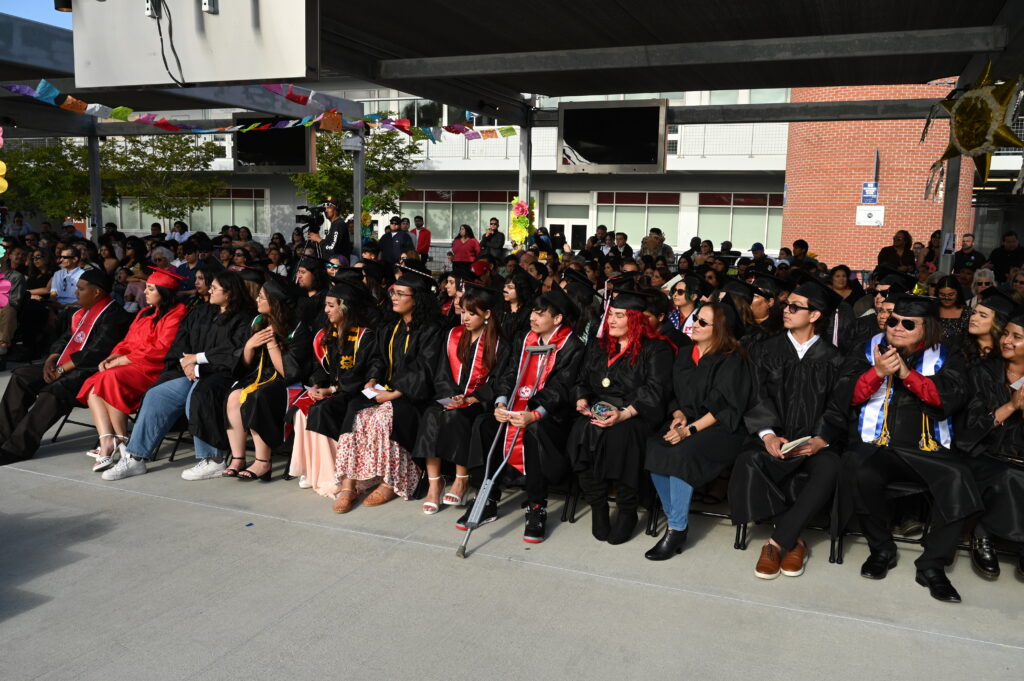
San Diego Unified teachers protest pink slips before a school board meeting last year. The district plans to issue 30 preliminary layoff notices this year.
Courtesy of San Diego Education Association
Second-grade teacher Jacob Willis has worked in the San Diego Unified School District in different roles since he graduated from high school in 2016. Now, he is one of hundreds of California teachers waiting to see if they will still have a job when campuses reopen next school year.
Declining enrollment, expiring federal funds for Covid relief, plus a proposed state budget with no new money for education made school leaders in 100 of California’s 1,000 school districts nervous enough about balancing their districts’ budgets to issue layoff notices to 1,900 teachers — 16 times more than the 124 that were issued last spring, according to the California Teachers Association.
State law requires that districts send pink slips by March 15 to any teacher who could potentially be laid off by the end of the school year. Although many of the layoff notices are withdrawn by May 15 — the last day final layoff notices can be given to tenured teachers — the practice is criticized by many for being demoralizing to teachers and disruptive to school systems.
“It creates serious insecurity and stress for teachers, including those who are ultimately asked to stay,” said Ken Jacobs, co-chair of the UC Berkeley Labor Center. “This will make it harder for districts to hire teachers and leads teachers to leave the profession.”
Holding out hope
Willis, 26, knows that with the state’s enduring teacher shortage he could find a teaching job at another school district, but he’d rather not. His heart is at San Diego Unified, where he started as a noon duty assistant at age 18. He watched over students during recess and lunch for four years while completing his teaching credential.
“I have no intention to stop teaching,” said Willis, who is in his second year as a teacher. “This is what I went to school for. This is what I intended to do for my whole career arc and life.”
The month since the pink slips were issued has been a tough one for Willis and his class at Porter Elementary, who learned of his potential layoff when he appeared on the local news. They are upset that he might not be on campus when they return for third grade, he said.
“There’s so much uncertainty,” Willis said. “There’s a chance that my pink slip might be rescinded. There’s a chance that it might not be rescinded, or I have to go to a different site. … It’s really stressful because I don’t know at all what’s going to happen.”
Almost a quarter of the pink slips issued in California were from Anaheim Union High School District, which issued 226, and San Diego Unified School District, which initially sent out 208 layoff notices. As of Friday, Anaheim had rescinded at least 55 notices and San Diego Unified 30, according to district officials.
San Diego Unified, the state’s second-largest district, employs 4,290 teachers, while Anaheim Union High School District has about 1,346 teachers, according to 2022-23 data from the National Center for Education Statistics.
“We haven’t seen layoffs on this scale in San Diego since 2017,” said Kyle Weinberg, president of the San Diego Education Association, referring to the notices of possible layoffs.
Pink slips don’t necessarily mean job loss
Districts generally send out more notices than the number of positions they might need to eliminate to ensure they meet the state requirement. Some pink slips are rescinded after district officials review credentials, expected retirements and projected enrollment numbers at school sites, and hearings with an administrative law judge are held to determine who stays and who goes.
In San Diego, all the teachers still holding pink slips by the end of last week were probationary employees, said Mike Murad, spokesperson for the district. When the dust settles, Anaheim Union High School District expects to lay off 119 teachers by the end of the school year, while San Diego has said the number will likely be 127.
Teachers are generally considered probationary if they have been with the district two years or less, are working in the district on an emergency-style credential or are hired into a position with restricted funding.
The president of the state’s largest teachers union blamed the pink slips on reduced funding and officials who issue more layoff notices than necessary. “Unfortunately, a lot of districts go to it as if it’s like a playbook,” said David Goldberg, president of the California Teachers Association.
School districts should look to their reserves to fund these positions next school year, he said.
Teacher layoffs are complicated
Generally, teacher layoffs are based on seniority, although districts can skip more junior teachers if they have special training and experience to teach a specific course that a more senior teacher does not. Pink-slipped teachers, who can prove they have more seniority than another teacher with equal expertise, can also bump that teacher and take that position, resulting in a reshuffling of teachers in multiple schools.
In Anaheim, the district protected 16 categories of teachers from layoffs, leading to layoff notices for more senior staff that included a teacher with 25 years of experience, said Geoff Morganstern, president of the Anaheim Secondary Teachers Association. The teacher has since had the pink slip rescinded, but others with 10 to 16 years of service have still not had layoff notices revoked, he said.
San Diego Unified also is not issuing layoff notices to teachers in some difficult-to-fill positions, and expects to have job openings in some credential areas, including special education, math and science, according to district officials.
Revenue dips prompt layoffs
Potential staff reductions at San Diego Unified are the result of the loss of nearly $540 million in Covid-relief funds, declining enrollment and projections of decreased state revenue, said board President Shana Hazan.
“As a district, we are committed to balancing our budget without significant impacts to students and school sites,” Hazen said. “Over the last year, our team has worked to thoughtfully and strategically build a budget that considers the needs of our children first and foremost.”
The district is trying to maximize attrition to minimize layoffs, she said. “We are hopeful we can continue to reduce the actual number of employees affected before May 15, when reductions are to be finalized.”
The San Diego Education Association has asked district officials to tap reserves to pay teacher salaries and to eliminate positions as teachers retire or leave the district, Weinberg said.
Anaheim Union High School Superintendent Michael Matsuda blamed the layoffs in the district on budget deficits brought on, in part, by the loss of 3,500 students. The district had used one-time state funds to extend a three-year agreement, made during the 2017-18 school year, to temporarily increase teaching staff to address critical needs in core content areas, he said in a video statement to the school community. The funds are running out, according to the district.
Union officials would have liked to have seen the district offer a retirement incentive this year and to manage declining enrollment through attrition and smaller cuts, but district officials didn’t want to spend the money, Morganstern said. The district has many teachers ready to retire, he added.
Layoffs can hurt teacher recruitment
Teacher layoffs during the Great Recession, between 2007 and 2009, are widely considered to be one of the causes of the current teacher shortage because they discouraged people from entering teacher preparation programs.
“It’s a huge risk that the district is taking (by) not rescinding the layoff notices,” Weinberg said. “We are the only large district and the county that’s doing layoff notices, and there are plenty of vacancies in other districts that our educators will apply for, and they will accept jobs. And that’s going to be devastating for our students who have relationships with those educators.”
A Commission on Teacher Credentialing report released last week shows that enrollment at teacher preparation programs declined another 10% in 2022-23, the most recent year data is available, following a 16% decline the previous year.
Issuing layoff notices during a teacher shortage can be particularly tricky for districts that are still trying to find teachers for hard-to-fill positions, like those with special education, math and science credentials.
Local teachers unions have been holding rallies to gain community support and to put pressure on district officials to rescind the pink slips.
“If we are able to win and have all of the layoff notices rescinded, we will have the smaller class sizes that our students need and that we’ve seen with the additional funds during the pandemic,” Weinberg said.
Morganstern expects all classes in Anaheim Union High School District to reach their maximum allowed capacity of students if the pink slips aren’t all recalled, with some classes going over the limit. The union will file grievances in those cases because it’s a contract violation, he said.
“Then they’re going to have to scramble to hire teachers, and then they’re going to have to issue massive schedule changes because every kid’s schedule has to be rearranged because of these couple teachers at each school,” Morganstern said. “It’s going to be a disaster.”



